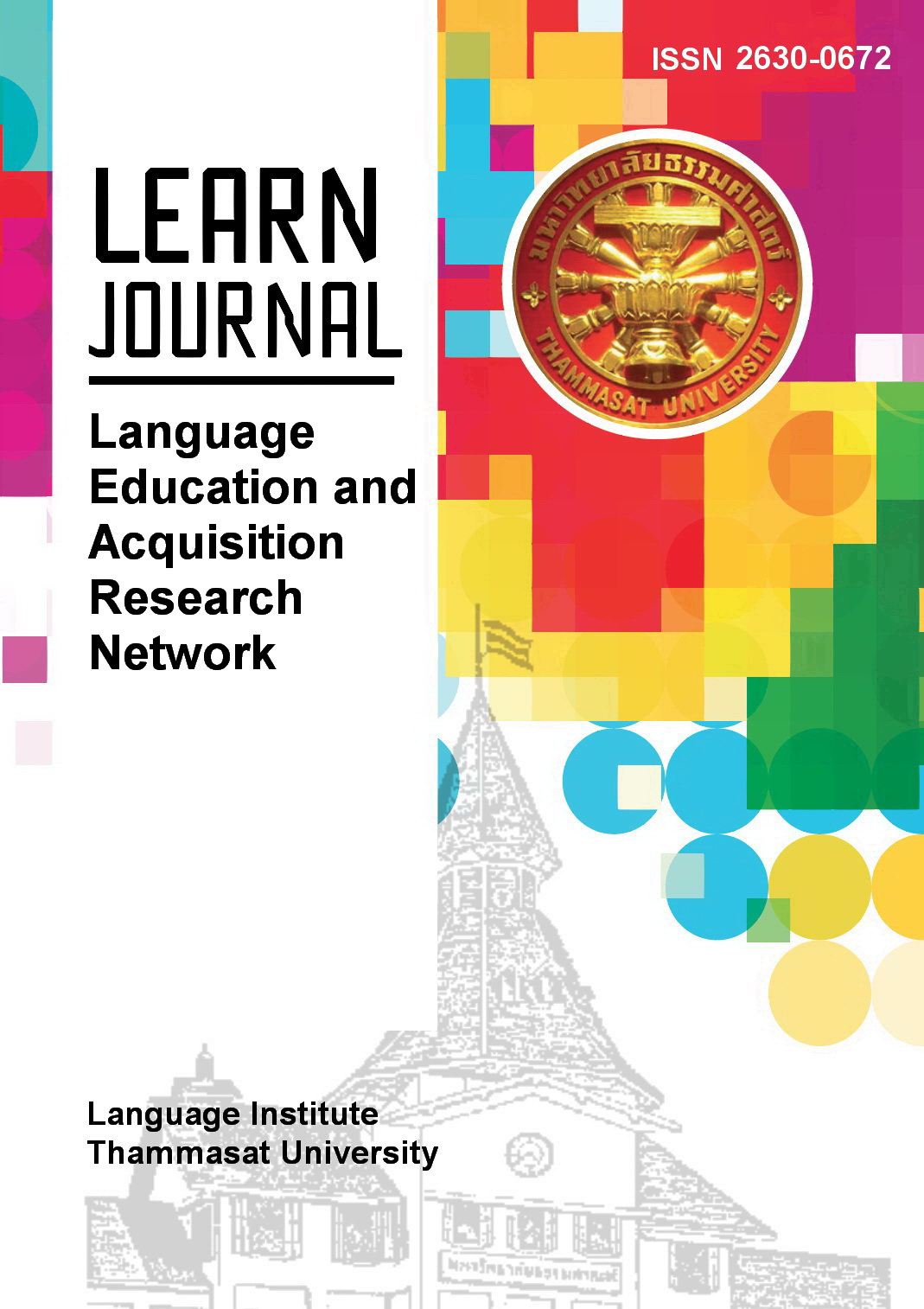A Move Analysis of Travel Advertorials in a UK National Daily Newspaper
Main Article Content
Abstract
With borders reopening after the Covid-19 pandemic, the travel industry has employed different methods to attract potential customers. One of the popular promotional strategies is advertorials. This study examines 75 travel advertorials from the Telegraph, a national daily newspaper in the UK, to address two objectives – 1) to identify moves and steps used in these advertorials and 2) to investigate the moves’ typicality and cyclicity. The findings reveal six moves along with some steps. Apart from the headline to attract readers’ attentions, key components in travel advertorials include descriptions of the destination and service, reasons to buy the product and advertiser’s contact details. On the contrary, pricing incentives are not highlighted. The findings could be beneficial to both students and ESP practitioners especially those who are involved in writing promotional materials. Guidelines for travel advertorial writing could be developed for ESP classroom teaching and professional trainings whereby learners can grasp the organizational structure and be aware of the typicality and cyclicity of moves used in travel advertorials.
Article Details
References
Amnuai, W. & Wannaruk, A. (2013). An analysis of moves in introductions in international and Thai journal research articles. PASAA, 45, 61-90.
https://www.culi.chula.ac.th/publicationsonline/files/article/b8EJjbj5slMon35921.pdf
Berkenkotter, C. & Huckin, T. N. (1993). Rethinking genre from a sociocognitive perspective. Written Communication, 10(4), 475-509. http://doi.org/10.1177/0741088393010004001
Bhatia, V. K. (1993). Analysing genre: Language use in professional settings. Longman Group, UK Limited.
Bhatia, V. K., (1995): Genre-mixing and in professional communication: The case of 'private intentions' v. 'socially recognised purposes. https://www.researchgate.net/publication/313524094
Bhatia, V. K. (2004). Worlds of written discourse. A genre-based view. London Continuum International.
Bhatia, V. K. (2005). Generic patterns in promotional discourse. In Halmari, H. & Virtanen, T. (Eds.), Persuasion across genres (pp.213-228). John Benjamins Company.
Bhatia, V. K. (2017). Analysing discourse variation in professional contexts. In V. Bhatia & S. Bremmer (Eds.), The Routledge handbook of language and professional communication (pp. 3-11). Routledge.
Cameron, G. T., Ju-Pak, K. H., & Kim, B. H. (1996). Advertorials in magazines: Current use and compliance with industry guidelines. Journalism & Mass Communication Quarterly, 73(3), 722-733.
Cameron, G. T. & Ju-Pak, K.-H. (2000). Information pollution? Labeling and format of advertorials in national newspapers. Newspaper Research Journal, 27(1), 65-76. https://doi.org/10.1177/07395329000210010
Deng, L., Laghari, T., & Gao, X. (2021). A genre-based exploration of intertextuality and interdiscursivity on advertorial discourse. English for Specific Purposes, 62, 30-42. https://doi.org/10.1016/j.esp.2020.11.003
Dentsu. (2021, January 27). Advertising’s return to growth powered by digital as marketers eye road to recovery. https://www.dentsu.com/uk/en/media-and-investors/ad-spend-report-2021#top
Fairclough, N., (1993). Critical discourse analysis and the marketization of public discourse: The universities. Discourse and Society, 4(2), 133-168. https://doi.org/10.1177/0957926593004002002
Fisher, B. (2019, July 25). UK digital ad spend by industry 2019. Emarketer. https://www.emarketer.com/content/uk-digital-ad-spending-by-industry-2019
Fisher, B. (2021, September 24). Big swings in UK digital as spending by industry, but retail pulls ahead. eMarketer. https://www.emarketer.com/content/big-swings-uk-digital-ad-spending-by-industry-retail-pulls-ahead
Glenday, J. (2021, November 21). Travel ad spend takes off with predicted 33% growth in 2022. The Drum. https://www.thedrum.com/news/2021/11/22/travel-ad-spend-takes-with-predicted-36-growth-2022
Graham, M., Milanowski, A., Miller, J. (2012). Measuring and promoting inter-rater agreement of teacher and principal ratings. Center for Compensation and Reform. https://www.researchgate.net/publication/265562724
Guttmann (2021, September 4). Advertising spend in the world’s largest ad markets 2020. Statista. https://www.statista.com/statistics/273736/advertising-expenditure-in-the-worlds-largest-ad-markets/
Herman, J. (2016, July 24). How sponsored content is becoming king in a Facebook world. The New York Times. https://www.nytimes.com/2016/07/25/business/sponsored-content-takes-larger-role-in-media-companies.html
Kanoksilapatham, B. (2005). Rhetorical structure of biochemistry research articles. English for Specific Purposes, 24(3), 269-292. https://doi.org/10.1016/j.esp.2004.08.003
Kanoksilapatham, B. (2015). Distinguishing textual features characterizing structural variation in research articles across three engineering subdiscipline corpora. English for Specific Purposes, 37, 74-86. https://doi.org/10.1016/j.esp.2014.06.008
Kim, B., Pasadeos, Y., & Barban, A. (2001). On the deceptive effectiveness of labeled and unlabeled advertorial formats. Mass Communication & Society, 4(3), 265-281. https://doi.org/10.1207/S15327825MCS0403_02
Landis, J. R., & Koch, G. G. (1977). The measurement of observer agreement for categorical data. Biometrics, 33(1), 159–174. https://doi.org/10.2307/2529310
Laosrirattanachai, P., & Laosrirattanachai, P. (2023). Analysis of vocabulary use and move structures of the World Health Organization emergencies press conferences on Coronavirus disease: A corpus-based investigation. LEARN Journal: Language Education and Acquisition Research Network, 16(1), 121–146. https://so04.tci-thaijo.org/index.php/LEARN/article/view/263436
Luo, J. & Huang, T. (2015). Genre-based analysis of American tourism brochures. Open Journal of Social Sciences, 3(9), 200-208, http://doi.org/10.4236/jss.2015.39028
Mediatique (2018). Overview of recent dynamics in the UK press market. Mediatique Limited.
Panseeta, S., & Todd, R. W. (2014). A genre analysis of 5-star hotels’ responses to negative reviews on Tripadvisor. rEFLections, 18, 1-13. https://so05.tcithaijo.org/index.php/reflections/article/view/114196
Pasavaravate, 2011. Genre analysis of thesis and dissertation abstracts in linguistics written by students in Thailand and students in England. [Doctoral dissertation, Chulalongkorn University]. http://cuir.car.chula.ac.th/bitstream/123456789/36620/1/yanatchapim_pa.pdf
Ratanakul, S. (2017). A study of problem-solution discourse: Examining TED Talks through the lens of move analysis. LEARN Journal: Language Education and Acquisition Research Network, 10(2), 25–46. https://so04.tci-thaijo.org/index.php/LEARN/article/view/111706
Shukor, Z. A. (2003). A genre-based analysis of print advertisements for hospitality and tourism. [Masters Dissertation, University of Malaya]. http://studentsrepo.um.edu.my/720/
Stephen, A. & Patra. R. K. (2015). Advertorials as a public relations tool and its impact on newspapers and readers. The Asian Conference on Mass Media and Communication Proceedings. https://www.researchgate.net/publication/337649139
Swales, J.M. (1990). Genre analysis: English in academic and research settings. Cambridge University Press.
Thumvichit, A., & Gampper, C. (2018). A comparative genre analysis of hotels’ responses to negative reviews. The International Journal of Communication and Linguistic Studies, 16(3-4), 1–16. https://doi.org/10.18848/2327-7882/CGP/v16i02/1-16
Wilson, R.T. & Baack, D.W. (2019). An exploration of advertorials used to attract foreign investments. Journal of Current Issues and Research in Advertising, 41(1), 36-53. https://doi.org/10.1080/10641734.2018.1557090
Zhou, S. (2012). ‘Advertorials’: A genre-based analysis of an emerging hybridized genre. Discourse & Communication, 6(3), 323-346. https://doi.org/10.1177/175048131244626


